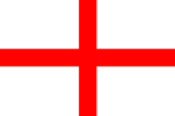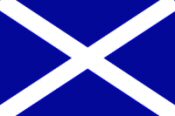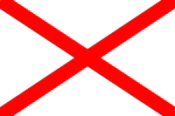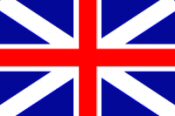|
The Union Flag The flag is normally - but incorrectly - called the "Union Jack" because it represents the union of England, Ireland, and Scotland (the flag does not include a flag from Wales because Wales is a principality in its own right and has never been ruled in the same way.) It is correctly called the Union Flag, as a jack is a flag that is flown on a jackstaff - a small flagpole on the back of a ship. It is only a Union Jack if it is being flown on a jackstaff. The Union Flag combines the crosses of St. George for England, St. Andrew for Scotland and St. Patrick for Ireland. (The St. Andrew's and St. Patrick's crosses are saltires - diagonal crosses.)
In 1603 James V1 of Scotland came to the English throne as James 1 and united the two countries, and in 1606 the the first Union flag was born. This combined the cross of St. George with the saltire of St. Andrew. Because of the strict rules of heraldry, where white is considered a "metal" and red and blue as "colours", and a colour cannot be superimposed directly onto another colour nor metal upon metal, the red cross had to be bordered with white in order to separate the two colours. This version of the flag was used until 1801.
In that year, Ireland became united officially with England, so the Nation's flag had to be changed to include the St. Patrick's cross a (red saltire - diagonal cross - on white). Each flag had to retain its individual identity yet at the same time merge into one, so the red crosses of England and Ireland were each given their original white background and were superimposed onto the St. Andrew's saltire.
Please note that the flag is NOT symmetrical : the white stripes on either side of the red saltire (diagonal) are not the same width and differ on either side of the central cross. On the side next to the flagpole, called the hoist, the broader white stripe is above the red stripe on both diagonals, the white stripe being part of the cross of St Andrew and the red stripe part of the cross of St Patrick. On the side that flutters free - the fly - this is reversed, with the Irish flag above the Scottish flag. The proportions of the modern Union Flag are unusual : most flags are in the ratio of 5 units wide to 3 units deep, whereas the Union Flag is in the ratio of 2 : 1 (that is, twice as wide as it is deep.) The stripes are also in a set ratio : horizontally they are blue 25 : white 2 : red 6 : white 2 : blue 25; vertically b10:w2:r6 : w2 : b10, and the diagonal stripes are w1:r2:w3, with the wider white stripe at the top on the hoist and bottom on the fly as explained before. According to popular tradition, flying the flag upside down is a distress signal although I suspect that if you were close enough to be able to tell you would also notice that something was wrong anyway! In these days of long-distance communication flag signals are taught less and less, but it's still a useful detail to know. Flying the flag upside-down deliberately is also considered "lese Majeste" (which means "insult the monarchy"), and is in theory at least still a crime in the UK and its commonwealth. |
Print
this page using the "Print" option on your browser bar, or
highlight (left-click/drag) and copy (Ctrl-C) & paste (Ctrl - V)
to MS Word or a similar program. |






